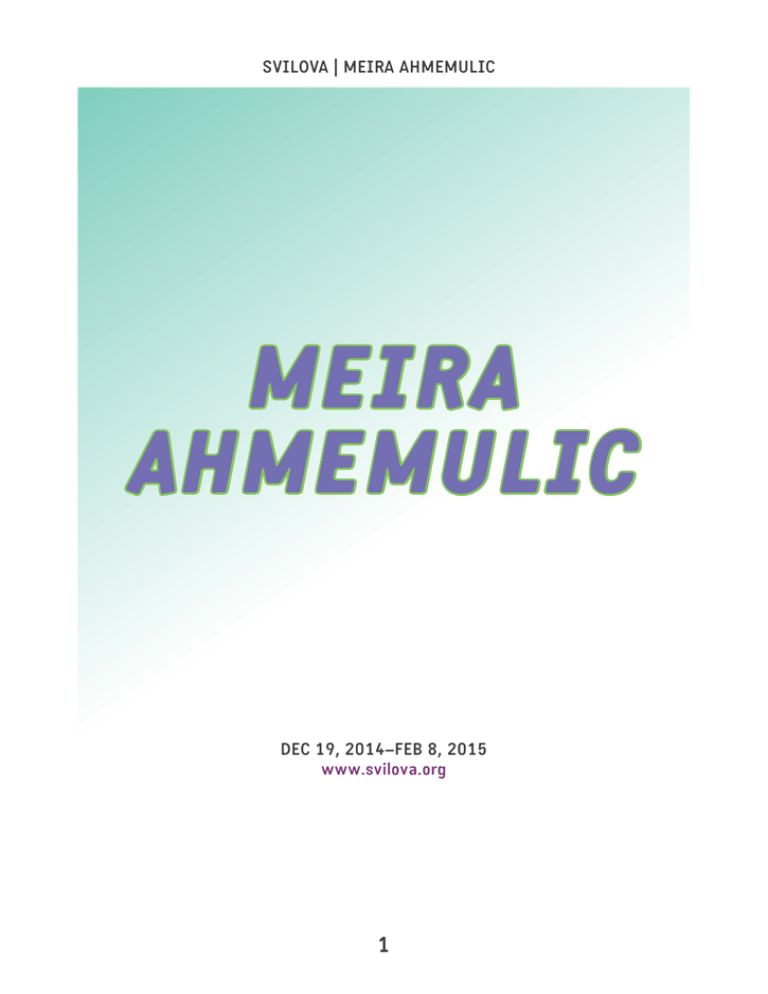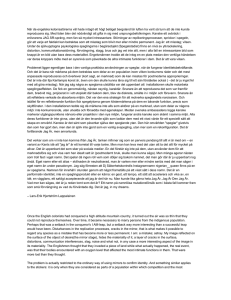SVILOVA | MEIRA AHMEMULIC DEC 19, 2014–FEB 8, 2015 www
advertisement

SVILOVA | MEIRA AHMEMULIC meira ahmemulic DEC 19, 2014–FEB 8, 2015 www.svilova.org 1 SVILOVA | MEIRA AHMEMULIC Foreign land By Khashayar Naderehvandi It seems to be about distance. Or perhaps a certain stance – adequately described as a cold point of view, stripped of the comfort of proximity; no embraces, no reconciliation, only the cold recording of an attentive, dissecting eye. The camera follows the artist’s mother at a distance, as she walks through various semi-public spaces in what appears to be the outskirts of a city. A voice reads out the text, calmly, with no tremor – always the same, regardless of the emotional content in what is being read: “her life-size body constituted the map, divided into different colour fields. Worn out joints and atrophied muscles, injuries caused by heavy physical labor, held together and separated the parts of the body.” a real distance, but rather a space that makes it possible for the actual work to be performed within language. The voice over-text binds the two figures – artist and mother – together. It is by virtue of its sensitivity that the text takes a risk, and so, holds them in a tight embrace, collapsing the distance between the two. At the same time, it establishes a different rift; namely, between the two of them, on one hand, and on the other hand, the entire scenery. As the text closes the gap between artist and mother, and directs our attention towards the distance between the subjects of the film and a specific part of the city, the dwelling-place emerges as a focal point in history, geography, politics, and more, whose mode of being is the very opposite of the work of Meira Ahmemulic. The dwelling-place itself is so much lacking in responsiveness, and attentiveness, that it, knowingly or unknowingly, rips bodies to shreds, erasing their histories, and holding them in place, in what will forever be for them a foreign land. But soon it becomes clear that the coldness with which the camera registers and with which the text was written – that is, the very position that so sternly resists atonement – is, in fact, directed elsewhere. The physical distance presented in the imagery – between the artist/camera, on one hand, and her mother, on the other hand – is not 2 SVILOVA | MEIRA AHMEMULIC meira ahmemulic, still images from Foreign Land, 2014, image courtesy of the artist. Främmande land Men snart blir det klart att kylan med vilken kameran registrerar och med vilken texten skrevs – det vill säga, den position som så strängt motstår försoning – i själva verket är riktad någon annanstans. Det fysiska avståndet som bildspråket presenterar – mellan konstnären/kameran å ena sidan, och hennes mor å andra sidan – är inget riktigt avstånd, utan snarare ett utrymme som gör det möjligt för det verkliga arbetet att utföras i språket. Röstpåläggningen binder ihop de två gestalterna – konstnär och mor. Det är i egenskap av sin lyhördhet som texten tar en risk, och på så sätt håller dem tätt omfamnande, låter avståndet mellan dem kollapsa. Samtidigt etableras en annan reva; nämligen mellan dem båda å ena sidan, och, å andra sidan, hela sceneriet. I och med att texten Det förefaller handla om avstånd. Eller möjligen ett slags hållning – väl beskrivet som en kall utgångspunkt, avklätt från den tröst som kommer av närhet; inga omfamningar, ingen försoning, bara det uppmärksamma, dissekerande ögats kalla registrering. Medan konstnärens mor promenerar genom olika halvpublika stadsrum i vad som ser ut att vara utkanterna av en stad, följer kameran henne på avstånd. En röst läser ut texten, lugnt, utan darrning på rösten – hela tiden likadant, oberoende av det lästas känslomässiga innehåll: “Hennes kropp i naturlig storlek utgjorde kartan uppdelad i olika färgfält. Förslitningar i leder, muskler som förtvinade, skador som uppstått av tungt fysiskt arbete höll ihop och separerade kroppsdelarna.” 3 SVILOVA | MEIRA AHMEMULIC stänger klyftan mellan konstnär och mor, och leder uppmärksamheten till avståndet mellan filmens subjekt och en specifik stadsdel, träder boplatsen fram som en fokuspunkt i historien, geografin, politiken, med mera, vars existensmodus är just motsatsen till Meira Ahmemulics arbete. Boplatsen själv brister så mycket i lyhördhet och uppmärksamhet att den – vetande eller ovetande, sliter sönder kroppar i stycken, raderar deras historia, och håller dem på plats, i vad som för alltid kommer att vara ett främmande land för dem. Khashayar Naderehvandi is a poet and literary critic. He made his debut in 2011 with the collection of poems Om månen alls syntes (If the moon were at all visible), and last year his novel Vilar i era outtröttliga händer (Resting in your unwearied hands) was published. In 2014, he was awarded Swedish Radio’s short story award. Khashayar Naderehvandi är poet och litteraturkritiker. Han debuterade 2011 med diktsamlingen Om månen alls syntes och utkom förra året med romanen Vilar i era outtröttliga händer. 2014 mottog han Sveriges Radios Novellpris. ABOUT THE ARTIST Meira Ahmemulic är född i Halmstad, och är verksam i Göteborg och Berlin. Hennes senaste arbeten handlar framförallt om språk och migration, släkt och förflyttningar – geografiskt och klassmässigt. Hon är utbildad på Valands Konsthögskola och är också verksam som författare. Tillsammans med konstnären Thomas Wiczak ger hon i december ut Wetterstation Berlin på Kning Disc om amerikanernas största avlyssningsstation i Europa under kalla kriget. Meira Ahmemulic was born in Halmstad, Sweden and works in Gothenburg and Berlin. Her works often deal with language and migration, family and dislocation – geographically and in terms of class. M. Ahmemulic studied at the Academy of Valand and is also a published author. Together with the artist Thomas Wizcak she is releasing Wetterstation Berlin in December at Kning Disc about Americas largest monitoring station in Europe during the Cold War. more info: www.svilova.org info@svilova.org 4

